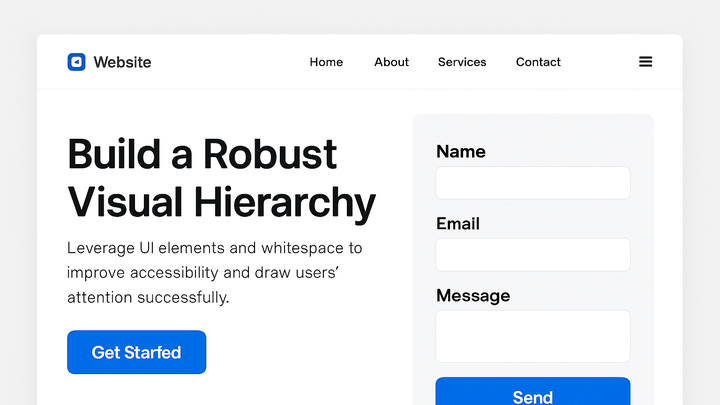Published on 2025-06-29T19:12:51Z
What is User Interface (UI)? Examples and Best Practices
User Interface (UI) refers to the visual layout and interactive components that users engage with on a website, including buttons, menus, forms, and imagery. In the context of Conversion Rate Optimization (CRO), a clear and engaging UI reduces friction and directs visitors toward desired actions such as sign-ups or purchases. From a UX perspective, intuitive UI design fosters user satisfaction, decreases bounce rates, and encourages repeat visits. UI also influences SEO performance; search engines factor in user engagement metrics, which are directly affected by the quality of the interface. Tools like Prevue.me offer actionable critiques to refine UI elements, boosting lead generation, improving accessibility, and maximizing overall site effectiveness. By focusing on aspects such as visual hierarchy, responsive layouts, and user feedback, teams can create interfaces that not only look appealing but also perform exceptionally across devices and audiences.
User interface (ui)
The visual and interactive elements of a website that shape user interactions and impact CRO, UX, and SEO.
Why UI Matters in CRO, UX, and SEO
A website’s UI directly impacts how users perceive and interact with content, influencing conversion rates, overall satisfaction, and search engine rankings.
-
Conversion rate impact
A clear, intuitive UI guides users to calls-to-action, reduces friction, and boosts conversion metrics.
- Cta visibility:
Strategic placement and styling of call-to-action buttons increase click-through rates.
- Form usability:
Streamlined, easy-to-complete forms reduce abandonment and improve lead generation.
- Cta visibility:
-
User satisfaction and engagement
Effective UI enhances user experience by facilitating easy navigation and providing feedback, reducing bounce rates.
- Navigation ease:
Intuitive menus and clear labels help users find information quickly.
- Visual feedback:
Animations, hover states, and loading indicators reassure users and maintain engagement.
- Navigation ease:
-
Seo performance
Search engines evaluate user engagement signals, which are directly affected by the UI’s usability and performance.
- Mobile-friendly design:
Responsive UI ensures consistent experience across devices, enhancing mobile search rankings.
- Page speed:
Optimized UI assets and code result in faster load times, a key SEO ranking factor.
- Mobile-friendly design:
Key Components of Effective UI
Building a successful UI involves combining design elements like layout, typography, and interactive features to create a coherent user journey.
-
Layout and structure
Defines the arrangement and hierarchy of content to guide user flow and focus attention.
- Grid systems:
Use consistent grids to align elements and maintain visual balance.
- Whitespace:
Adequate spacing enhances readability and reduces cognitive load.
- Grid systems:
-
Typography and color
Font choices and color schemes affect legibility and brand perception.
- Readable fonts:
Select clean, web-safe fonts that scale well across devices.
- Contrast ratios:
Ensure sufficient contrast between text and background for accessibility.
- Readable fonts:
-
Interactive elements
Buttons, links, and form fields drive user actions and need clear affordances.
- Button states:
Design distinct hover, active, and disabled states for clarity.
- Form validation:
Provide real-time feedback to reduce errors and frustration.
- Button states:
-
Imagery and icons
Visuals communicate messages quickly and add aesthetic value.
- High-quality images:
Use optimized images to ensure clarity without sacrificing performance.
- Consistent iconography:
Maintain a unified style for icons to support intuitive navigation.
- High-quality images:
Best Practices and Optimization Techniques
To maximize the effectiveness of your UI, apply best practices that improve accessibility, performance, and consistency.
-
Accessibility compliance
Design for users with disabilities by following WCAG guidelines and accessible design patterns.
- Aria labels:
Implement ARIA attributes to enhance screen reader support.
- Keyboard navigation:
Ensure all interactive elements are reachable and operable via keyboard.
- Aria labels:
-
Performance optimization
Reduce load times and resource usage to improve user experience and SEO.
- Code minification:
Minify CSS and JavaScript files to decrease download size.
- Lazy loading:
Defer loading of off-screen images and components until needed.
- Code minification:
-
Consistency and branding
Maintain a cohesive design language across your site to reinforce brand identity.
- Design systems:
Use a shared component library and style guide to streamline development.
- Brand guidelines:
Adhere to defined palettes, typography, and visual standards.
- Design systems:
Tools and Resources for UI Evaluation
Leverage specialized tools and platforms to audit, test, and refine your UI for optimal performance.
-
Prevue.me
A SaaS platform offering actionable critiques on UI to enhance lead generation, CRO, UX, SEO, and accessibility.
- Automated ui audits:
Generates detailed reports identifying UI strengths and weaknesses.
- Prioritized fixes:
Provides a ranked list of UI improvements to achieve maximum impact quickly.
- Automated ui audits:
-
Google lighthouse
An open-source tool for auditing performance, accessibility, and best practices.
- Performance metrics:
Analyzes page speed, interactivity, and visual stability.
- Accessibility checks:
Detects issues like missing alt text and insufficient color contrast.
- Performance metrics:
-
Hotjar
User behavior analytics tool that records sessions and generates heatmaps.
- Session recordings:
Watch real user interactions to uncover UI friction points.
- Heatmaps:
Visualize click, move, and scroll behavior to optimize layouts.
- Session recordings:
